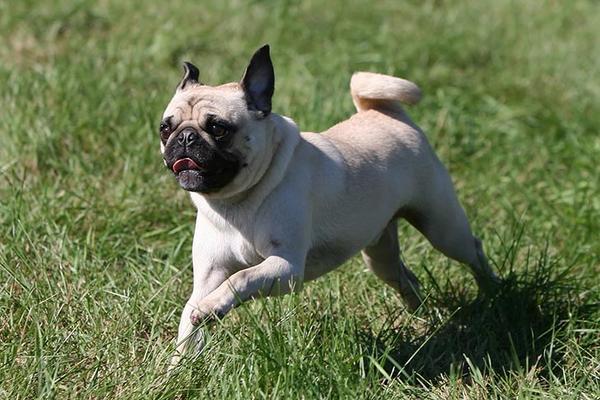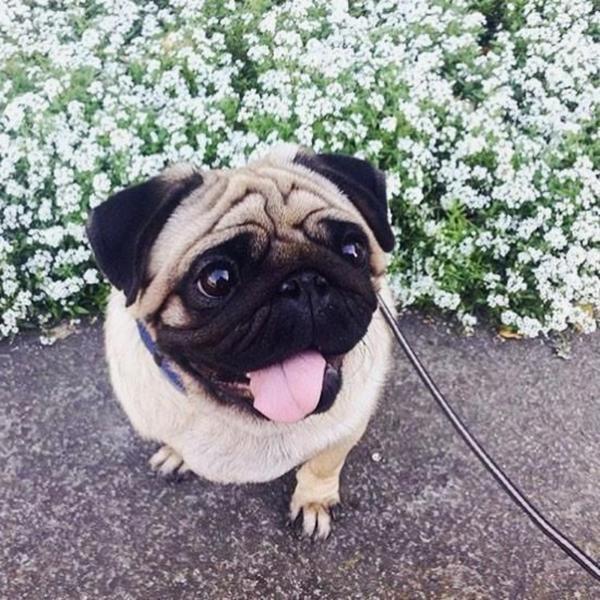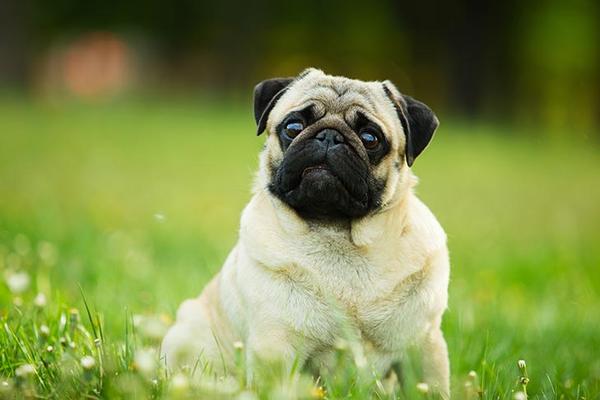Pug
also known as Dutch Bulldog, Dutch Mastiff, Carlin, Mini Mastiff, Mops, Chinese Pug

 History
History
The Pug is a small, affectionate dog breed with a distinctive wrinkled face and curly tail that has been beloved by people for centuries. The breed's origins can be traced back to China, where they were kept by imperial families and were considered a symbol of good luck.
The Pug's name is thought to have originated from the Latin word "pugnus," meaning "fist," because their face resembles a clenched fist. The breed was then brought to Europe in the 16th century by traders and became a popular pet among European royalty, including Queen Victoria.
In addition to being kept by imperial families in ancient China and being popular among European royalty in the 16th century, Pugs were also popular among the Dutch royal family in the 17th and 18th centuries. This is when the breed was first introduced to Europe, the Dutch East India Company traders brought the Pug with them to Holland and the Pug soon became a favorite of the House of Orange.
Pugs were also popular among the French court during the 18th century, where they were known as "Mopshond" in Dutch, which means "to grumble or grumble." This is where the Pug gets its nickname "the clown of the dog world" because of its comical expression.
The Pug was first registered with the American Kennel Club (AKC) in 1885 and with the United Kennel Club (UKC) in 1894. The breed's popularity continued to grow in the 19th and 20th century, and today the Pug is one of the most beloved dog breeds in the world.
Pugs are known for their playful and affectionate nature, making them great companion dogs. They are also known for their adaptability, and can thrive in both small apartments and large homes. They are good with children and other pets, and are known to be excellent therapy dogs.
Historic figures associated with the breed include the 18th century artist, William Hogarth, who painted several portraits of his own pug dog named Trump, which served as an emblem of the artist’s own pugnacious character and acted as a statement of the artist’s professional ambition. Queen Victoria, who was an avid fan of the breed. Today, the Pug continues to be a beloved companion dog and is widely recognized by major kennel clubs around the world.
Breed Information
Is Pug a purebred?
Purebred
What were Pugs originally used for?
Companion
How Long Do Pugs Live? What is average life expectancy for a Pug? How long can Pugs live?
12-15 years
The average Pug lifespan is somewhere between 12-15 years, provided they aren't beset by any exceptional health issues or injuries.
Pug Height & Weight
How big is a full grown Pug?

| Height | ||||
|---|---|---|---|---|
| Average | 6 months | 12 months | 18 months | |
| Male | 12-14 inches (30.5 - 35.6 cm) | 4.5 inches (11.4 cm) | 7.0 inches (17.8 cm) | 11.5 inches (29.2 cm) |
| Female | 10-12 inches (25.4 - 30.5 cm) | 4.5 inches (11.4 cm) | 7.0 inches (17.8 cm) | 10.0 inches (25.4 cm) |
| Weight | ||||
|---|---|---|---|---|
| Average | 6 months | 12 months | 18 months | |
| Male | 13-20 pounds (6 - 9 kg) | 7.0 pounds (3 kg) | 11.0 pounds (5 kg) | 15.5 pounds (7 kg) |
| Female | 13-18 pounds (6 - 8 kg) | 6.5 pounds (3 kg) | 10.5 pounds (5 kg) | 14.5 pounds (7 kg) |
Do Pugs get fat easily?
![]()
![]()
![]()
![]()
![]()
They are known for having a strong tendency to become overweight. It is important to find a balance between providing enough exercise and controlling their food intake. To maintain a healthy weight, it is recommended to increase the frequency and duration of daily walks and to engage in more playtime with the Pug.
Are Pugs Hypoallergenic?
No
Unfortunately, the Pug is not hypoallergenic, making it not a good choice for a dog lover who suffers from pet allergies.
What is a Pug personality? What are Pug dogs best known for?
Affectionate
Courageous
Intelligent
Going
Loyal
Cheerful
Gentle
Friendly
Playful
Are Pugs heavy shedders? How Much Does a Pug Shed?
![]()
![]()
![]()
![]()
![]()
Pug dogs are heavy shedders, they will lose a significant amount of hair each year. To decrease the amount of shedding, you can regularly brush your Pug. This will remove loose hair and keep his coat growing in the same direction.
What is the watchdog ability of a Pug dog?
![]()
![]()
![]()
![]()
![]()
The Pug dogs are average watchdogs. If they sense something different, this breed will alert their owner.
Breed History
Where do Pugs come from?
China
What are Pugs descended from?
Pekingese, Bulldog, French Mastiff
What organizations or kennel clubs recognize/register the Pug breed?
American Canine Registry
American Kennel Club
America's Pet Registry
Canadian Kennel Club
Dog Registry of America Inc.
Federation Cynologique Internationale
Kennel Club of Great Britain
North American Purebred Registry, Inc.
American Canine Association, Inc.
Australian National Kennel Council
Continental Kennel Club
National Kennel Club
New Zealand Kennel Club
United Kennel Club
When were Pugs first bred? How old is the Pug breed?
Ancient Times
What Breed Group is a Pug?
Toy (AKC:1885)
Companion breeds (UKC)

Pug Appearance
What color are Pug eyes?
Brown
What color can Pug nose be naturally?
Black
What color can Pug coat be naturally?
Black
Fawn
How long is a Pugs coat?
![]()
![]()
![]()
![]()
![]()
Pugs are known for their short coat.
How Dense Is The Pug Coat?
![]()
![]()
![]()
![]()
![]()
What is the texture of the hair of a Pug?
Straight
How many puppies can a Pug have in a litter? How many puppies can a Pug have in her first litter?
12-15 puppies per pregnancy
A Pug can have a litter of 12-15 puppies on average. However, it's worth noting that the size of the litters can vary greatly. Factors that can influence litter size include the health of the mother, breeding history, and genetics.
![]()
![]()
![]()
![]()
![]()
Pugs are known for their adaptability and versatility, they are capable of adapting well to a wide range of lifestyle changes and living environments. They are a highly adaptable breed, and make great companions for families and individuals of all lifestyles.

Pug Health Issues
Do Pugs have a lot of health problems?
![]()
![]()
![]()
![]()
![]()
The Pug is a very healthy breed, with little need for frequent vet visits. However, it's important to keep an eye on their health and have them checked by a veterinarian when needed.
What are the major health concerns to be aware of when owning a Pug?
Entropion
Legg-Calve-Perthes Disease
Portosystemic Shunt
Pug Dog Encephalitis
Necrotizing Meningoencephalitis
What are the less significant issues to keep in mind when it comes to Pugs?
Allergies
Corneal Ulcer
What are the occasional tests recommended for Pug breed?
Eye
Blood Test
Liver Ultrasound
X-Rays
CT Scan
Eye Examination
Physical Examination
Allergy Tests

Pug Needs and Activities
Do Pugs have a lot of energy?
![]()
![]()
![]()
![]()
![]()
For those who lead a balanced lifestyle, Pugs may be a good choice as they have an average energy level.
Do Pugs need socialization? How social are Pugs?
![]()
![]()
![]()
![]()
![]()
Pug have very high social needs. These needs include regular mental and physical stimulation, a job or purpose, and companionship. They thrive in environments where they have a lot of interaction with humans and other dogs.
How much exercise should Pugs get?
![]()
![]()
![]()
![]()
![]()
The Pugs a breed that requires only a small amount of physical activity to maintain a healthy lifestyle. These breeds are ideal for people with busy lifestyles, elderly people or those who have limited mobility. They also make great pets for those who live in small apartments or have limited outdoor space.
How much sleep should a Pug have? Do Pugs sleep a lot?
![]()
![]()
![]()
![]()
![]()
The Pug breed is known for its moderate energy levels and normal sleep patterns, typically sleeping around 12-14 hours per day.
Does a Pug drool a lot?
![]()
![]()
![]()
![]()
![]()
The Pug is a breed of dog that is characterized by its minimal drooling, making it an ideal choice for people who dislike drool marks on their clothing.
How much does it bark?
![]()
![]()
![]()
![]()
![]()
Pugs tend to bark moderately, they bark when necessary, such as to alert their owner or to communicate something. They may also bark due to certain triggers like fear, alarm, boredom, greeting, separation anxiety and compulsive barking.
Do Pugs exhibit aggressive behavior to safeguard their home and territory? Do they possess a natural tendency to guard?
![]()
![]()
![]()
![]()
![]()
These dogs are known for their strong territorial instinct and protective nature. They will fiercely defend their territory and are highly alert and vigilant against any perceived threat to their home and family.
Are Pugs mouthy?
![]()
![]()
![]()
![]()
![]()
What is the likelihood of a Pug running away? Do they have a tendency to explore or wander frequently?
![]()
![]()
![]()
![]()
![]()
Do Pug dogs have a high prey drive?
![]()
![]()
![]()
![]()
![]()
What do Pugs enjoy doing? How do I keep my Pug busy?
Go to Park, Walk, Eating Snacks, Nap, Playdate, Tug-of-war, Fetch, People watching, Sleeping, Walking, Petting, Sitting, Chase, Run, Barking, Running, Dog park, Very slow, Sniffing, Swim, Smell, Snacks, Explore, Walks, Pets, Jumping, Treats, Resting, Slow walking, Peanut butter
What is the energy level of a Pug? How much energy does a Pug have?
Medium
Pugs are medium-energy dogs and typically enjoy socializing and playing casual or even sustained games of chase with other dogs. They may also have occasional periods of barking or racing around the house.
![]()
![]()
![]()
![]()
![]()
How far should a Pug walk each week? How many miles should a Pug walk every week?
5 miles / week
There's really no limit to how far you walk your dog as long as they're comfortable. For Pug, it's at least 5 miles / week. Just remember to build distance and stamina gradually over time.
How much a Pug should exercise a day? How much activity does a Pug need?
40 minutes
In general most Pugs usually need at least 40 minutes of exercise daily. This can be spread across the day and include all sorts of high-energy activities, like walking, running and playing.
What level of grooming should be provided for a Pug?
![]()
![]()
![]()
![]()
![]()
The Pug is a breed of dog that does not require extensive grooming.
How often should you brush a Pug?
Weekly
Pug should be brushed at least once a week. Of course you can give them more frequent brushes if you find that they are still shedding a lot
What are the most commonly used brushing tools for Pugs?
Slicker Brush
Scissors
Nail Clipper
Costs
How many cups of food does a Pug eat?
1 cups
For an average 13-20 pound (6 - 9 kg) Pug feed 1 cups daily. But, keep in mind, the amount you feed is going to be dependent on the quality of the food you are feeding.
How Much Does a Pug Cost Daily?
$1.40 - $1.70 / day
The average cost of a Pug is somewhere $1.40 - $1.70 per day.
How Much Does a Pug Cost Per Month?
$35 - $50 / month
The average per month expenses of a Pug is between $35 - $50. This makes an average of $420 - $600 per year. It will be on the higher side when the dog is still small because it will need more frequent visits to the vet, shots.
Pug Characteristic
How intelligent is a Pug?
![]()
![]()
![]()
![]()
![]()
The Pug have below the average degree of obedience intelligence among other breeds. However, calling them “dumb dogs” is unfair. Where Pugs lack in obedience & working intelligence, they make up for it with their keen ability to understand human emotions.
How sensitive is a Pug dog?
![]()
![]()
![]()
![]()
![]()
Pug dogs have average emotions and are adaptable to different situations, not requiring extra care like sensitive breeds do.
Are Pug dogs affectionate?
![]()
![]()
![]()
![]()
![]()
Do Pug do well in apartments? Are Pugs good indoor dogs?
![]()
![]()
![]()
![]()
![]()
Pugs are known for being excellent apartment dogs. They are fairly active indoors and will do okay without a yard.
Are Pugs good with kids? Are Pugs good around children?
![]()
![]()
![]()
![]()
![]()
Pugs are kid-friendly dogs. They are good with children and excellent dogs with children if they are socialized and trained at a young age.
Are Pugs good for elderly?
![]()
![]()
![]()
![]()
![]()
Are Pugs good with cats? How friendly Pugs are toward cats?
![]()
![]()
![]()
![]()
![]()
Pugs are very cat friendly dogs. They generally make good companions for cats.
Do Pug dogs get along with other dogs? Are Pugs OK with other dogs?
![]()
![]()
![]()
![]()
![]()
Pugs are very friendly towards other dogs. This breed typically have a happy and affectionate temperament around dogs.
How do Pug dogs interact with other pets? Are they considered pet-friendly?
![]()
![]()
![]()
![]()
![]()
Are Pugs friendly with strangers?
![]()
![]()
![]()
![]()
![]()
Pugs are very friendly around strangers.
Do Pugs like to play? Are Pugs playful?
![]()
![]()
![]()
![]()
![]()
Pugs have an average level of playfulness. The Pugs, like other dogs, like to play. But they are not the most playful dog breed.
Are Pug easily trained?
![]()
![]()
![]()
![]()
![]()
Pug may require more time, repetition and patience to learn commands than other breeds, and can be challenging to teach new things, but with patience and consistency, they can be trained.
 Pros & Cons
Pros & Cons
Pros
- Cat Friendly
Pug dogs get along well with cats. - Therapy Dog
Therapy dog tasks are well within this breed's capabilities. - Friendly
Pug is a friendly and outgoing, making them great with children and other pets. - Size
Pug is a small dog, making them suitable for apartment living or small homes.
Cons
- Odor
The Pug's tendency to produce a bad smell is high. - Not suitable for office environment
An office is not the best place for a Pug. - Shedding
Pugs dog breed that sheds heavily. - Tendency to gain weight
The Pug breed is particularly inclined to being overweight. - Not Hypoallergenic
People with allergies should be aware that Pugs may cause allergic reactions. - Health concerns
The Pug breed, like others, may have certain health conditions that they are prone to, such as Entropion, Legg-Calve-Perthes Disease, Portosystemic Shunt, Pug Dog Encephalitis and Necrotizing Meningoencephalitis.